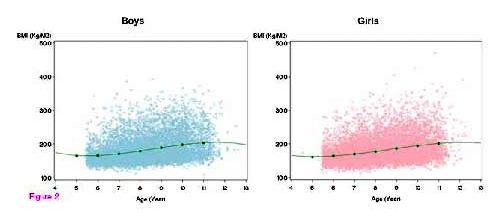Today we review research into the links if any between traffic-related pollution and obesity in pre-teen children. Results indicate that children have a higher body mass index (BMI) who live in an area with higher traffic density and related pollution. Noting the direct health impacts of air pollution, this appears to be a combination of the known lower levels of physical exercise near heavy traffic, as well as such factors as drive-in fast food joints and their negative effect on healthy diets and obesity in children. Solutions include such basics as better land use planning to brings homes and jobs closer together, more use of public transit and less of private car commuting and limiting heavy traffic from the vicinity of schools and parks.

Key Quotes:
“Since the 1970s rates of overweight and obesity have more than doubled in the U.S. from about 15% of youth aged 2–19 years who were considered overweight or obese, to 32% in 2003–2006”
“Recently, researchers examined longitudinally the role of traffic density around the homes of children. They found that higher levels of vehicular traffic were associated with higher attained body mass index (BMI measured as kg/m2) in children aged 10–18”
“Heightened traffic danger may discourage children from engaging in active transport by foot or bicycle for utilitarian purposes …and other things being equal, this would lower overall physical activity and could contribute to a positive energy balance.”
“Other research indicates that air pollution exposure, with traffic as a major source in many cities, may operate through inflammatory pathways to initiate metabolic processes contributing to diabetes formation”
“Comparing children in the highest 10% of traffic-related air pollution exposure to those in the lowest 10% of exposure yielded a 0.39 BMI unit increase in the attained BMI level at age 10…This translated into a 13.6% increase in the rate of average annual BMI growth.”
“the results indicate that traffic-related pollution likely has a stronger effect than traffic density,”
"The effects of pollution are significant, and the temporal pattern is consistent with the hypothesis that the inflammatory effects of air pollution predispose children to obesity in a similar way to what has been observed in laboratory experiments”
“Traffic pollution may be controlled via emission restrictions; changes in land use that promote jobs-housing balance and use of public transit and hence reduce vehicle miles traveled; promotion of zero emissions vehicles, transit and car-sharing programs; or by limiting high pollution traffic, such as diesel trucks, from residential areas or places where children play outdoors, such as schools and parks. These measures may have beneficial effects in terms of reduced obesity formation in children.”






No comments:
Post a Comment